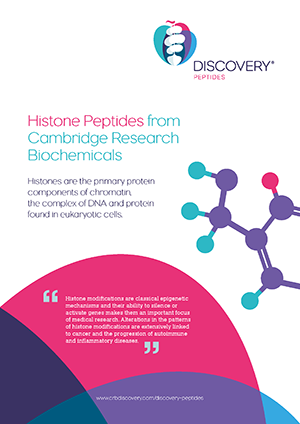Histone Peptides
Histones are the primary protein components of chromatin, the complex of DNA and protein found in eukaryotic cells. Its primary function is compacting DNA molecules.
Five major families of histones exist, H1/H5, H2A, H2B, H3, and H4. Histones H2A, H2B, H3 and H4 are the core histones, while histones H1/H5 are linker histones, with the core histones acting as spools around which DNA winds. Each of the largely globular histone proteins possesses a characteristic tail which is densely populated with lysine and arginine residues, which are subject to extensive post-translational modifications that cooperate to govern the chromatin state. At least eight distinct types of modifications are known, with enzymes existing for acetylation, methylation, demethylation, phosphorylation, ubiquitination, sumoylation, ADP-ribosylation, deimination, and proline isomerization. Similarly to DNA methylation, post-translational histone modifications do not affect the DNA nucleotide sequence but instead modify its availability to the transcriptional machinery and thus influence gene expression. Histone acetylation usually leads to higher gene expression whereas histone methylation can either allow or repress transcription depending on the location and number of modifications.
Histone modifications are classical epigenetic mechanisms and their ability to silence or activate genes makes them an important focus of medical research. Alterations in the patterns of histone modifications are extensively linked to cancer and the progression of autoimmune and inflammatory diseases.
Showing 1–16 of 57 results
-
[5-FAM] Histone H3 (1-14) K4Me3
ART-[K(Me3)]-QTARKSTGGK-[5-FAM]-amide
View products -
Acetyl-Histone H4 (1-21)Ac-SGRGKGGKGLGKGGAKRHRKV-amide
View products -
Acetyl-Histone H4 (1-21) K5Ac, K8Ac, K12Ac, K16Ac-GG-[Lys(5-FAM)]Ac-SGRG-[K(Ac)]-GG-[K(Ac)]-GLG-[K(Ac)]-GGA-[K(Ac)]-RHRKV-GG-[K(5-FAM)]-amide
View products -
Acetyl-Histone H4 (1-23) K16Ac-GG-[Lys(5-FAM)]Ac-SGRGKGGKGLGKGGA-[K(Ac)]-RHRKVLR-GG-[K(5-FAM)]-amide
View products -
Acetyl-Histone H4 (1-23)-GG-[Lys(5-FAM)]Ac-SGRGKGGKGLGKGGAKRHRKVLR-GG-[K(5-FAM)]-amide
View products -
Biotin-Histone H3 (14-34) K23Me3Biotin-KAPRKQLAT-[K(Me)3]-AARKSAPATGG-acid, Where K(Me)3 is Tri-Methylated Lysine
View products -
Biotin-Histone H3 (14-34) pT22 K23Me3
Biotin-KAPRKQLA-[pT]-[K(Me)3]-AARKSAPATGG-acid
View products -
H4 peptide (16-23)KRHRKVLR-acid
View products -
Histone H1 derived peptideGGGPATPKKAKKL-acid
View products -
Histone H2A (1-20)SGRGKQGGKARAKAKTRSSR-acid
View products -
Histone H2A (1-20)-GGK(Biotin)SGRGKQGGKARAKAKTRSSR-GGK(Biotin)
View products -
Histone H2A (78-86)RIIPRHLQL-acid
View products -
Histone H2AB1 (22-30)AGLQFPVGR-acid
View products -
Histone H3 (1-15) K4Me3, K9Ac, pS10
ART-[K(Me3)]-QTAR-[K(Ac)]-[pS]-TGGKA-acid
View products -
Histone H3 (1-18)ARTKQTARKSTGGKAPRK-acid
View products -
Histone H3 (1-20)ARTKQTARKSTGGKAPRKQLW-acid
View products


